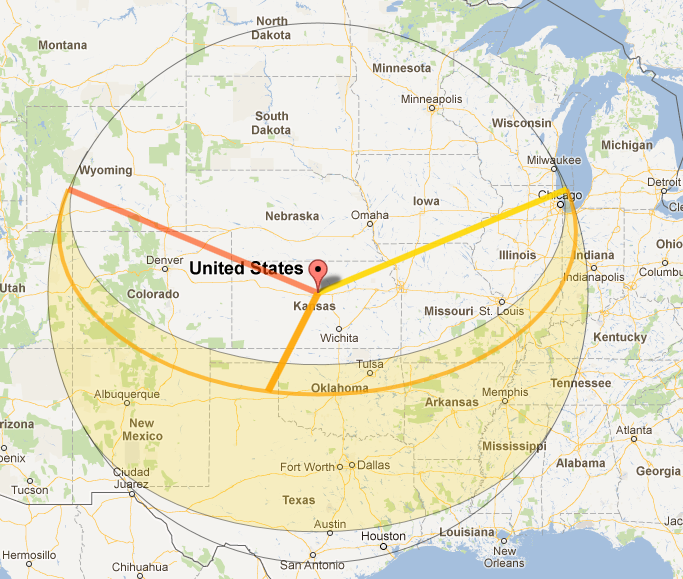In the earlier post on this topic, I wrote about the common myth that the sun is directly overhead at noon. Here, we’ll take a look at the even more common belief that the sun rises in the east and sets in the west.
You can generally answer almost any simple question about the position of the sun in the sky if you keep in mind three basic rules:
- On each equinox the sun rises (nearly) due east and sets (nearly) due west. Its position near noon is determined by the latitude. On these days the sun should be directly overhead if you are on the equator (0 degrees latitude). If you are not on the equator than your latitude tells you how much you have to change the angle of your sight to look directly at the sun. For example, if you are at 20 degrees north latitude, then you will have to tilt your head 20 degrees (from “straight up” position) to the south. If you are at 50 degrees south latitude, you will need to tilt your head that many degrees to the north.
- Because Earth is tilted approx. 23 and a half degrees, the position of the sun near noon will move by this amount (north or south) throughout the year. If you are at 30 degrees north latitude (near Austin, Texas), then the sun will appear only 30-23.4 = 6.6 degrees south of “straight up” in the heart of summer, generating Texas’ legendary heat. However, in the dead of winter, the sun will be 30+23.4=53.4 degrees south of “straight up,” leading to a mild environment.
- For those in the northern hemisphere, the sun moves south after it rises until around noon. Then it moves northward until it sets. (This is in addition to its prevailing, general westward motion.)
I wrote about the first two points in the previous post on this topic. The third point generalizes one of the observations made in the first point. If the sun rises due east and is due south around noon, then it must have traveled southward during the morning. Similarly, if it is due south around noon and sets due west, it must have traveled northward in the PM hours. Most of the time, the sun does not rise due east or set due west, but it still follows the same pattern of moving southward until around noon and then moving back northward. In the southern hemisphere, the pattern is reversed. The sun moves northward from sunrise to noontime and the moves southward in the later hours.
Keeping the above notes in mind, let’s consider the question “To someone in Kansas, what direction is sunset around May 20?”
The spring equinox typically occurs around March 20th. We know that the sun rises due east on that day. By noon it appears to the south. Then it sets due west. The noontime sun in the summer is also in the south, but it is closer to being overhead. Instead of being, say 39 degrees south at noon, it might be only 19 degrees south in late May. The noontime position of the sun has moved northward around 20 degrees! (By the summer solstice it will have moved northward 23.4 degrees.)
In fact, the entire path of the sun has been shifted northward, meaning that the sun does not rise due east in summer but actually rises a little north of due east. Similarly, it does not set due west but rather a bit north. The noontime position of the sun has moved northward by 20 degrees, but the position of sunset has actually moved northward more. To understand why recall that the sun moves northward from noon until evening: sunset is now occurring at a later time, so the sun has more time to arc northward before it is swallowed by the horizon. Instead of being 20 degrees north of “due west,” the sun sets about 26 or 27 degrees north of due west, closer to NW than due west.
The effect for sunrise is the same: the sun rises about 26 or 27 degrees north of due east, so closer to NE than east.
The image below illustrates the narrative above. It depicts the path of the sun as seen from Golden Belt, KS. The orange arc shows the path traced out on March 20th. The sun rises nearly exactly due east (marked by the yellow line) and sets nearly exactly due west (shown by the reddish line). The orange line describes the direction to the sun’s image around 11 am.
The orange region contains the possible paths of the sun on other days. The upper edge is the path the sun takes on the summer solstice: the sun rises east northeast and sets west northwest. The lower edge is the path in the middle of winter. Then it rises east southeast and sets west southwest. Below, I have inserted an image showing the path for today, August 5. The golden line segment running east northeast points in the direction of sunrise. The reddish line pointing west northwest points in the direction sunset. Here the orange bar describes the path to the sun around 1 pm.
It turns out that, for most people in the US, the sun rises in the east about half the time, about a quarter of the time it rises closer to NE and about a quarter of the time it rises closer to SE. You can investigate the situation for your own location by using two nifty online tools. One is the sun position tool at sunearthtools.com. The other is suncalc.net, which I used to make the images above.
I should stress that for most points in the US the effect is mild. to illustrate this, think of a compass as a clock face, with north at 12 o’clock and south at 6 o’clock. For those living in the mid-latitudes of the U.S. (e.g., Kansas, Washington DC, Northern California), you can roughly say the sun rises at the 2 o’clock position in June and July, at 4 o’clock position in December and January, and at 3 o’clock (due east) in the months near the equinoxes (September, August, March, April).
For those living further north, the effect is more pronounced. For someone on the arctic circle, the sun rises in the north near the summer solstice!
One interesting mathematical challenge you may wish to pose to a precocious math student is “Where does the sun rise at the equator on a solstice?” It turns out to be 23.5 degrees (the same as the Earth’s tilt) north or south of due east (depending on which solstice). A corollary to this observation is that every person in the northern hemisphere sees the sun rise closer to NE than due east on that day.





4 comments
1 ping
Skip to comment form ↓
Jill K Thayer
July 28, 2013 at 6:10 pm (UTC 0) Link to this comment
I live in up in northern Washington, close to the Canadian Border, so is it true that the sun rises in the northeast and sets in the northwest?
Rudel
August 21, 2013 at 8:28 pm (UTC 0) Link to this comment
In summer, yes. In Winter, the sun stays to the south the whole day.
Thanks for stopping by!
Helen Sausser
August 1, 2014 at 6:39 pm (UTC 0) Link to this comment
Thank you for an understandable explanation. I am an 80 yr old
and becoming more and more curious about such things. I live on I-80 in Northern CA and watch the sun come up each morning from my bedroom window. Now I know why it is so far to the North in July and so far to the South in December. Helen
Rudel
August 6, 2014 at 8:39 am (UTC 0) Link to this comment
You are most welcome, Helen, and I’m glad it was helpful.
Best,
David
Where is the Sun? (Addendum)
August 12, 2012 at 3:36 pm (UTC 0) Link to this comment
[…] « Where is the Sun: Part II […]